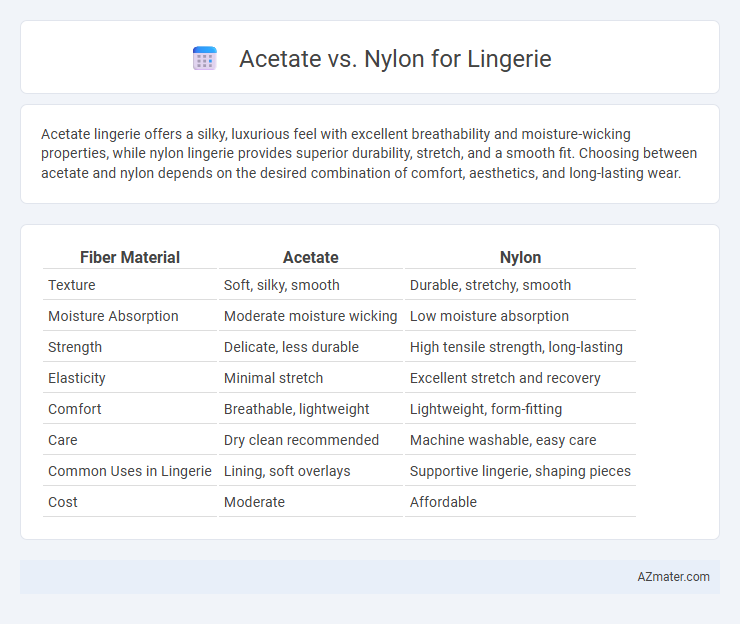Acetate lingerie offers a silky, luxurious feel with excellent breathability and moisture-wicking properties, while nylon lingerie provides superior durability, stretch, and a smooth fit. Choosing between acetate and nylon depends on the desired combination of comfort, aesthetics, and long-lasting wear.
Table of Comparison
| Fiber Material | Acetate | Nylon |
|---|---|---|
| Texture | Soft, silky, smooth | Durable, stretchy, smooth |
| Moisture Absorption | Moderate moisture wicking | Low moisture absorption |
| Strength | Delicate, less durable | High tensile strength, long-lasting |
| Elasticity | Minimal stretch | Excellent stretch and recovery |
| Comfort | Breathable, lightweight | Lightweight, form-fitting |
| Care | Dry clean recommended | Machine washable, easy care |
| Common Uses in Lingerie | Lining, soft overlays | Supportive lingerie, shaping pieces |
| Cost | Moderate | Affordable |
Introduction to Acetate and Nylon in Lingerie
Acetate and nylon are two popular fabrics used in lingerie, each offering distinct qualities to enhance comfort and style. Acetate, a semi-synthetic fiber derived from cellulose, is known for its silky texture, excellent drape, and vibrant color retention, making it ideal for luxurious and elegant lingerie pieces. Nylon, a synthetic polymer, provides exceptional strength, elasticity, and moisture-wicking properties, ensuring durability and a supportive fit in everyday lingerie collections.
Fabric Composition and Structure
Acetate fabric, derived from cellulose acetate fibers, offers a smooth, silky texture with a natural sheen, making it ideal for lingerie that emphasizes luxury and softness. Nylon, a synthetic polyamide fiber, provides exceptional strength, elasticity, and moisture-wicking properties, enhancing durability and comfort in intimate apparel. The structural difference lies in acetate's semi-synthetic origin and breathability versus nylon's synthetic, stretchable nature, influencing lingerie's fit, feel, and performance.
Sensory Experience: Feel and Comfort
Acetate lingerie offers a smooth, silky texture that feels cool and lightweight against the skin, enhancing comfort for prolonged wear. Nylon provides a soft yet slightly stretchier feel, offering greater flexibility and a snug fit that adapts to body movement. Both fabrics excel in breathability and moisture-wicking, but acetate tends to feel more luxurious, while nylon prioritizes durability and elastic comfort.
Breathability and Moisture Management
Acetate lingerie offers moderate breathability and a silky feel but tends to retain moisture, making it less ideal for extended wear in warm climates. Nylon fabrics provide superior moisture-wicking capabilities and enhanced airflow, promoting better breathability and comfort during prolonged use. Choosing nylon for lingerie ensures improved moisture management, reducing the risk of irritation and maintaining dryness throughout the day.
Durability and Lifespan
Acetate lingerie offers a silky texture and luxurious appearance but tends to have lower durability compared to nylon, as it is more prone to pilling and fabric weakening over time. Nylon lingerie stands out for its exceptional strength and elasticity, providing a longer lifespan with resistance to wear, stretching, and frequent washing. Choosing nylon ensures lingerie maintains shape and support through extended use, making it a practical option for durability-conscious consumers.
Aesthetic Appeal and Finish
Acetate lingerie offers a luxurious sheen and smooth finish that enhances visual appeal with a silky, satin-like texture, making it ideal for elegant, high-end designs. Nylon lingerie boasts a crisp, smooth surface with excellent color retention and durability, providing a sleek, modern look favored for everyday wear. The choice between acetate and nylon significantly influences lingerie aesthetics, balancing lustrous elegance against vibrant, long-lasting colors.
Care Requirements and Maintenance
Acetate lingerie demands gentle hand washing with mild detergents to prevent fabric damage and maintain its silky texture, while avoiding high heat during drying to retain shape. Nylon lingerie offers easier care with machine washability on delicate cycles and quick drying, but it is prone to pilling and requires air drying to preserve elasticity. Proper maintenance of both fabrics prolongs lingerie durability, with acetate needing more delicate handling compared to the more resilient, synthetic nature of nylon.
Allergenicity and Skin Sensitivity
Acetate lingerie is favored for its hypoallergenic properties, making it suitable for sensitive skin prone to irritation and allergies. Nylon, while durable and commonly used, can sometimes cause allergic reactions or skin sensitivity due to its synthetic nature and chemical processing. Choosing acetate over nylon can reduce the risk of redness, itching, and discomfort associated with fabric allergies in lingerie.
Sustainability and Environmental Impact
Acetate lingerie, derived from wood pulp, is partially biodegradable but often involves chemical-intensive production impacting ecosystems. Nylon, a synthetic polymer made from petrochemicals, has a significant carbon footprint and contributes to microplastic pollution during washing. Choosing sustainable lingerie favors natural fibers or recycled materials over acetate and nylon to reduce environmental harm.
Choosing the Right Material for You
Choosing between acetate and nylon for lingerie depends on your priorities for comfort, durability, and style. Acetate offers a smooth, luxurious feel with excellent moisture absorption, making it ideal for those seeking breathability and softness. Nylon provides superior strength and elasticity, ensuring a snug fit and long-lasting wear for everyday lingerie needs.

Infographic: Acetate vs Nylon for Lingerie
 azmater.com
azmater.com